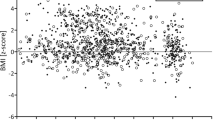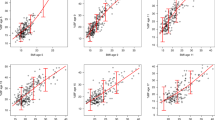Abstract
BACKGROUND: Body mass index (BMI) is widely used to assess the prevalence of childhood obesity in populations, and to infer risk of subsequent obesity-related disease. However, BMI does not measure fat directly, and its relationship with body fatness is not necessarily stable over time.
OBJECTIVE: To test the hypothesis that contemporary children have different fatness for a given BMI value compared to the reference child of two decades ago.
DESIGN: Comparison of children from Cambridge, UK with the reference child of Fomon and colleagues (Am J Clin Nutr 1982; 35: 1169–1175).
SUBJECTS: A total of 212 children aged 1–10.99 y.
MEASUREMENTS: Body composition was assessed by deuterium dilution. Fat-free mass and fat mass were both adjusted for height to give fat-free mass index and fat mass index.
RESULTS: Contemporary Cambridge children have similar mean BMI values to the reference child. However, both boys and girls have significantly greater mean fatness and significantly lower mean fat-free mass than the reference child after taking height into account. Contemporary Cambridge children have greater fatness for a given BMI value than the reference child.
CONCLUSION: BMI-based assessments of nutritional status may be under-estimating the increase in children's fatness. Any change over time in the relationship between BMI and body fatness will create a mismatch between (1) current estimates of childhood obesity and (2) predicted risk of future adult illness, calculated on the basis of longitudinal cohorts recruited in childhood several decades ago. However, an alternative interpretation is that the reference data are inappropriate. Caution should therefore be used in generalizing from this study, and further investigations of the issue are required.
This is a preview of subscription content, access via your institution
Access options
Subscribe to this journal
Receive 12 print issues and online access
$259.00 per year
only $21.58 per issue
Buy this article
- Purchase on Springer Link
- Instant access to full article PDF
Prices may be subject to local taxes which are calculated during checkout






Similar content being viewed by others
References
Troiano RP, Flegal KM, Kuczmarski RJ, Campbell SM, Johnson CL . Overweight prevalence and trends for children and adolescents: the National Health and Nutrition Examination Surveys, 1963 to 1991 Arch Pediatr Adolesc Med 1995 149: 1085–1091.
Reilly JJ, Dorosty AR . Epidemic of obesity in UK children Lancet 1999 354: 1874–1875.
Sokol RJ . The chronic disease of childhood obesity: the sleeping giant has awakened J Pediatr 2000 136: 711–713.
Must A, Strauss RS . Risks and consequences of childhood and adolescent obesity Int J Obes Relat Metab Disord 1999 23 (Suppl 2): S2–S11.
Garrow JS, Webster J . Quetelet's index (W/H2) as a measure of fatness Int J Obes 1985 9: 147–153.
Sardinha LB, Going SB, Teixeira PJ, Lohman TG . Receiver operating characteristic analysis of body mass index, triceps skinfold thickness, and arm girth for obesity screening in children and adolescents Am J Clin Nutr 1999 70: 1090–1095.
Cole TJ, Freeman JV, Preece MA . Body mass index reference curves for the UK, 1990 Arch Dis Child 1995 73: 25–29.
Cole TJ, Bellizzi MC, Flegal KM, Dietz WH . Establishing a standard definition for child overweight and obesity worldwide: international survey Br Med J 2000 320: 1240–1243.
Cole TJ . Weight/heightp compared to weight/height2 for assessing adiposity in childhood: influence of age and bone age on P during puberty Ann Hum Biol 1986 13: 433–451.
Prentice AM . Body mass index standards for children. Are useful for clinicians but not yet for epidemiologists Br Med J 1998 317: 1401–1402.
Sarria A, Garcia-Llop LA, Moreno LA, Fleta J, Morellon MP, Bueno M . Skinfold thickness measurements are better predictors of body fat percentage than body mass index in male Spanish children and adolescents Eur J Clin Nutr 1998 52: 573–576.
Pietrobelli A, Faith MS, Allison DB, Gallagher D, Chiumello G, Heymsfield SB . Body mass index as a measure of adiposity among children and adolescents: a validation study J Pediatr 1998 132: 204–210.
Wells JCK . A Hattori chart analysis of body mass index in infants and children Int J Obes Relat Metab Disord 2000 24: 325–329.
Fomon SJ, Haschke F, Ziegler EE, Nelson SE . Body composition of reference children from birth to age 10 y Am J Clin Nutr 1982 35: 1169–1175.
Davies PSW, Wells JCK . Calculation of total body water in infancy Eur J Clin Nutr 1994 48: 490–495.
Wells JCK, Fuller NJ, Dewit O, Fewtrell MS, Elia M, Cole TJ . Four-component model of body composition in children: density and hydration of fat free mass and comparison with simpler models Am J Clin Nutr 1999 69: 904–912.
Freeman JV, Cole TJ, Chinn S, Jones PR, White EM, Preece MA . Cross sectional stature and weight reference curves for the UK, 1990 Arch Dis Child 1995 73: 17–24.
Van Itallie TB, Yang M, Heymsfield SB, Funk RC, Boileau RA . Height-normalised indices of the body's fat-free and fat mass: potentially useful indicators of nutritional status Am J Clin Nutr 1990 52: 953–959.
Wells JCK, Cole TJ, ALSPAC study team. Adjustment of fat-free mass and fat mass for height in children aged 8 y Int J Obes Relat Metab Disord 2002 (in press)
Flegal KM . Defining obesity in children and adolescents: epidemiologic approaches Crit Rev Food Sci Nutr 1993 33: 307–312.
Moreno LA, Fleta J, Sarria A, Rodriguez G, Gil C, Bueno M . Secular changes in body fat patterning in children and adolescents of Zaragoza (Spain), 1980–1995 Int J Obes Relat Metab Disord 2001 25: 1656–1660.
Department of Transport. National travel survey: 1992/94 HMSO: London 1995.
Mason V . Young people and sport in England, 1994 The Sports Council: London 1995.
Office of Population Censuses and Surveys. General household survey HMSO: London 1994.
Torun B, Viteri FE . Influence of exercise on linear growth Eur J Clin Nutr 1994 48 (Suppl 1): S186–S189.
Ruxton CH, Reilly JJ, Kirk TR . Body composition of healthy 7- and 8-year-old children and a comparison with the ‘reference child’ Int J Obes Relat Metab Disord 1999 23: 1276–1281.
Reilly JJ, Savage SAH, Ruxton CHS, Kirk TR . Assessment of obesity in a community sample of prepubertal children Int J Obes Relat Metab Disord 1999 23: 217–219.
Guo SS, Roche AF, Chumlea WC, Gardner JD, Siervogel RM . The predictive value of childhood body mass index values for overweight at age 35 y Am J Clin Nutr 1994 59: 810–819.
Valdez R, Greenlund KJ, Wattigney WA, Bao W, Berenson GS . Use of weight-for-height indices in children to predict adult overweight: the Bogalusa Heart Study Int J Obes Relat Metab Disord 1996 20: 715–721.
He Q, Karlberg J . Prediction of adult overweight during the pediatric years Pediatr Res 1999 46: 697–703.
Charles MA . Actualites epidemiologiques de l'obesite et du diabete de type 2 en France Diabetes Metab 2000 26 (Suppl 3): 17–20.
Gunnell DJ, Frankel SJ, Nanchahal K, Peters TJ, Davey-Smith G . Childhood obesity and adult cardiovascular mortality: a 57-y follow-up study based on the Boyd Orr cohort Am J Clin Nutr 1998 67: 1111–1118.
Sinaiko AR, Donahue RP, Jacobs DR Jr, Prineas RJ . Relation of weight and rate of increase in weight during childhood and adolescence to body size, blood pressure, fasting insulin, and lipids in young adults. The Minneapolis Children's Blood Pressure Study Circulation 1999 99: 1471–1476.
Author information
Authors and Affiliations
Rights and permissions
About this article
Cite this article
Wells, J., Coward, W., Cole, T. et al. The contribution of fat and fat-free tissue to body mass index in contemporary children and the reference child. Int J Obes 26, 1323–1328 (2002). https://doi.org/10.1038/sj.ijo.0802077
Received:
Revised:
Accepted:
Published:
Issue Date:
DOI: https://doi.org/10.1038/sj.ijo.0802077
Keywords
This article is cited by
-
The associations of maternal and paternal obesity with latent patterns of offspring BMI development between 7 and 17 years of age: pooled analyses of cohorts born in 1958 and 2001 in the United Kingdom
International Journal of Obesity (2023)
-
Associations of extracurricular physical activity patterns and body composition components in a multi-ethnic population of UK children (the Size and Lung Function in Children study): a multilevel modelling analysis
BMC Public Health (2019)
-
BMI does not capture the high fat mass index and low fat-free mass index in children with cerebral palsy and proposed statistical models that improve this accuracy
International Journal of Obesity (2019)
-
Cancer, obesity, diabetes, and antidiabetic drugs: is the fog clearing?
Nature Reviews Clinical Oncology (2017)
-
Relationships between the lean mass index and bone mass and reference values of muscular status in healthy Chinese children and adolescents
Journal of Bone and Mineral Metabolism (2016)



